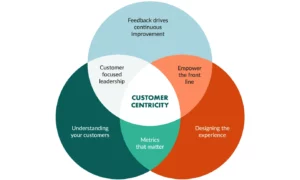This comprehensive guide from BrandingExperts.com is designed for everyone, from SEO beginners to seasoned professionals, offering a deep dive into the ever-evolving landscape of Google’s search engine results page (SERP). Our journey will unravel the technical and non-technical aspects of ranking at the top of Google searches, providing you with knowledge and practical tips. Whether you’re a junior marketer, a content creator, or a senior SEO strategist, this article help you with the complexities of Google’s algorithms.
What is the Google Algorithm?
The Google algorithm is a complex set of computational rules and procedures used by Google’s search engine to retrieve and rank web pages from its vast index in response to user queries. At its core, this algorithm is designed to deliver the most relevant, authoritative, and user-friendly search results to its users.
To define it technically, the Google algorithm employs ranking signals to evaluate web pages. These signals include but are not limited to keywords, site usability, page speed, and backlinks. The algorithm assesses these signals using sophisticated machine learning models and artificial intelligence to determine the relevance and quality of web pages.
The underlying principle of the Google algorithm is to enhance user experience. It aims to provide search results that answer the user’s query and offer credibility and value. For instance, when a user searches for information, the algorithm prioritizes web pages that are not only rich in relevant information but also from trustworthy and authoritative sources.
The Google algorithm is critical in aligning demand and supply in business and commerce. Accurately matching user queries with relevant business offerings facilitates a seamless connection between consumers and providers. This efficiency is crucial in the digital marketplace, where visibility in search results can significantly impact business success.
Understanding Google’s Algorithm Updates: A Comprehensive Overview
Understanding how these updates work, the factors influencing them, and their impact on SEO, content creation, and business practices is essential for anyone in the digital space.
- The Process of Algorithm Updates
1.1 Regular Updates for Relevance and Quality
Google continually refines its algorithm to enhance the accuracy and relevance of search results. These updates can be minor tweaks or significant overhauls to improve user experience and adapt to changing search behaviors and technology advancements.
1.2 Machine Learning and AI Integration
Integrating artificial intelligence and machine learning, like Google’s RankBrain, enables a more nuanced understanding of search queries. This evolution allows the algorithm to interpret the intent behind searches, providing more personalized and contextually relevant results.
- Factors Influencing Algorithm Updates
2.1 User Experience as a Priority
User experience is paramount. Site speed, mobile-friendliness, and easy navigation significantly influence algorithm updates. Google prioritizes websites that offer a seamless, user-friendly experience.
2.2 Content Quality and Relevance
High-quality, relevant content is crucial. Google updates its algorithm to identify better and rank content that offers value, accuracy, and depth on a given topic. This shift emphasizes the importance of well-researched, authentic content.
2.3 Combating Web Spam and Unethical Practices
Google continuously updates its algorithm to identify and penalize black-hat SEO tactics, such as keyword stuffing and cloaking. These updates aim to maintain fairness and integrity in search rankings.
- The Evolution of SEO and Content in Response to Google Updates
3.1 Adapting SEO Strategies
SEO professionals must adapt to these updates, focusing on creating quality content and optimizing user experience rather than exploiting loopholes in the algorithm.
3.2 Content Creation Aligned with User Intent
Content creators now focus more on addressing user intent and creating informative, engaging, and valuable content. This shift aligns with Google’s emphasis on content quality and relevance.
- Impact on Businesses and Teams
4.1 Varied Business Responses
Different types of businesses must adjust their online strategies in response to Google’s updates. E-commerce sites, for instance, need to ensure high-speed, mobile-optimized experiences, while content-driven sites must focus on producing original, insightful content.
4.2 Collaboration Across Teams
Algorithm updates have encouraged greater collaboration between SEO experts, content creators, and web developers. This collaboration ensures a holistic approach to align with Google’s criteria, combining technical optimization with quality content creation.
Key Milestones in Google’s Algorithm Updates: Insights and Impacts
Google’s algorithm updates have consistently shaped the digital landscape, bringing unique changes and insights.
- The Early Days: Understanding Relevance
1.1 Google Panda (2011)
Panda was a game-changer, focusing on the quality of content. It penalized websites with low-quality, thin content and boosted high-quality sites. This update made content creators and SEO professionals prioritize well-researched, informative content.
1.2 Google Penguin (2012)
Penguin targeted webpam and manipulative link-building practices. It emphasized the importance of natural, relevant backlinks and discouraged unethical SEO tactics like keyword stuffing and cloaking.
- Enhancing User Experience
2.1 Google Hummingbird (2013)
Hummingbird was pivotal in enhancing Google’s understanding of search queries. It moved beyond keywords to context and intent, making search results more relevant and personalized.
2.2 Mobilegeddon (2015)
This update prioritized mobile-friendly websites, acknowledging the surge in mobile internet usage. It was a wake-up call for businesses to adopt responsive web design and optimize for mobile users.
- Refining Content and User Interaction
3.1 Google RankBrain (2015)
RankBrain introduced AI, using machine learning to interpret complex queries and deliver more accurate results. It highlighted the need for SEO strategies to evolve beyond traditional keyword optimization.
3.2 Google BERT (2019)
BERT represented a significant leap in understanding natural language. It improved Google’s comprehension of the nuances and context within user queries, further refining search results.
- Recent Developments and Ongoing Evolution
4.1 Core Updates (2019-2023)
Google’s recent core updates have continuously refined its algorithms, focusing on site speed, user experience, and content quality. These updates underscore websites’ need to maintain a high technical SEO and content creation standard.
4.2 Passage Indexing (2021)
This update allowed Google to index individual passages from a webpage, helping surface relevant content even if the entire page is not focused on the user’s query. It encourages content creators to structure their information clearly and effectively.
The Process Behind Google’s Algorithm Updates: A Step-by-Step Overview
Google’s algorithm updates are not sudden or random. They are the result of a meticulous, well-structured process. Understanding this process sheds light on how search results evolve and change over time. Let’s walk through the stages Google typically goes through when releasing these updates.
- Identifying the Need for an Update
1.1 Analyzing User Behavior
Google constantly monitors how users interact with search results. Observing patterns, like frequent back-clicks to search results, may indicate that users are not finding what they need, prompting a reevaluation of the algorithm.
1.2 Gathering Feedback
Google also collects feedback from web admins, SEO specialists, and users. This feedback often highlights improvement areas, like better handling of specific content types or queries.
- Developing the Update
2.1 Research and Development
Google’s engineers and data scientists conduct extensive research. They analyze vast data to understand what changes might improve the search experience.
2.2 Testing and Refinement
Before a major update rolls out, Google rigorously tests it. This phase involves experimenting with the changes in a controlled environment, ensuring they positively impact search quality.
- Rolling Out the Update
3.1 Gradual Implementation
Updates, especially significant ones, are often rolled out gradually. This phased approach allows Google to monitor the impact and adjust if unforeseen issues arise.
3.2 Monitoring Impact
After the update goes live, Google closely monitors various metrics. It includes user satisfaction, search results’ relevance, and SEO community feedback.
- Post-Release Phase
4.1 Community Communication
Google communicates with the SEO and webmaster community through blogs or forums. This communication helps clarify the purpose of the update and any actions web admins should take.
4.2 Ongoing Adjustments
No update is final. Google continuously tweaks and adjusts its algorithms based on ongoing data and feedback. These minor changes might not be as noticeable as significant updates, but they are crucial in fine-tuning the search results.
Google’s Core and Minor Updates: Strategies for SEO and Content Optimization
In the ever-evolving world of SEO, understanding the nuances of Google’s core and minor updates is crucial. Each update can significantly impact your search engine rankings and online visibility. Here’s a comprehensive guide on how to navigate these updates effectively.
- Core Updates: Major Shifts in the SEO Landscape
1.1 Understanding Core Updates
Core updates are significant changes Google makes to its overall algorithm, influencing how it evaluates and ranks websites. These updates usually aim to improve the overall quality of search results by focusing on factors like content quality, user experience, and site functionality.
1.2 Adapting to Core Updates
When a core update rolls out, monitoring your website’s performance closely is vital. Look for changes in your search rankings and traffic. If you notice a drop, it may be time to reassess your content and SEO strategy. Focus on providing high-quality, relevant content and ensuring a seamless user experience.
- Minor Updates: Continuous Tweaks and Adjustments
2.1 Deciphering Minor Updates
Minor updates are more frequent but less noticeable changes that Google makes to refine its algorithm. While they might not cause significant ranking shifts, they are essential for fine-tuning your SEO strategy.
2.2 Responding to Minor Updates
Stay informed about these updates through SEO news sources and Google’s announcements. Minor updates often target specific niches or SEO practices, so understanding them can give you an edge in optimizing your content.
- Best Practices When Updates are Released
3.1 Stay Informed and Analyze
Keep abreast of update announcements from Google. Use analytics tools to check your website’s performance and identify areas for improvement.
3.2 Don’t Panic, Optimize
Take your time; don’t make drastic changes immediately after an update. Instead, focus on continuous improvement and adherence to SEO best practices.
- Impact of Updates on Different Stages of Content
4.1 New Content
For new content, focus on creating value-driven, user-centric content. Ensure that your content answers user queries effectively and is well-structured.
4.2 Existing Content
Regularly review and update your existing content. Ensure it remains relevant, accurate, and aligns with the latest SEO practices.
- Leveraging Updates to Your Advantage
5.1 Embrace the Change
View each update as an opportunity to improve your website and content strategy. Stay ahead of the curve by promptly adapting to new requirements and standards set by Google.
5.2 Continuous Learning and Adaptation
Stay informed about SEO trends and best practices. Attend webinars, read SEO blogs, and engage with the SEO community to keep your knowledge up-to-date.
Google’s Article Ranking Mechanism: Technical Insights and Updates
Understanding how Google ranks articles involves delving into a complex, multifaceted process. This system, governed by intricate algorithms, evaluates many factors to determine content’s relevance and authority. Let’s explore these technical intricacies and how updates can affect rankings.
- The Core of Google’s Ranking Algorithm
1.1 Keyword Analysis
At its most basic level, Google’s algorithm begins with keyword analysis. It evaluates how well keywords and their semantic variations align with user queries, considering their placement and context within the content.
1.2 Content Quality Assessment
Google employs advanced techniques to assess content quality. It looks for originality, depth, accuracy, and relevance. High-quality content is not just about well-written prose; it’s about delivering real value to the reader.
1.3 User Experience and Engagement Metrics
User experience metrics, such as click-through rates, time spent on a page, and bounce rates, play a crucial role. Google interprets these metrics as indicators of an article’s usefulness and engagement level.
- Authority and Trustworthiness
2.1 Backlink Profile
Google evaluates the amount and authority of backlinks to an article. Links from authoritative and relevant sites serve as endorsements, boosting the article’s credibility.
2.2 E-A-T Principle (Expertise, Authoritativeness, Trustworthiness)
Google’s guidelines emphasize the importance of expertise, authoritativeness, and trustworthiness, especially for YMYL (Your Money, Your Life) content. This principle ensures that content affecting users’ health, finance, or safety comes from credible sources.
- Technical SEO Factors
3.1 On-page Optimization
On-page specifications like title tags, meta descriptions, and structured data enhance an article’s visibility and relevance to specific queries.
3.2 Site Speed and Mobile Responsiveness
Google prioritizes articles from websites that load quickly and offer a mobile-friendly experience, reflecting its commitment to user-centric optimization.
- Impact of Algorithm Updates on Rankings
4.1 Shifts in Ranking Priorities
Algorithm updates often bring shifts in ranking priorities. For instance, an update might place more emphasis on mobile usability, instantly affecting the rankings of articles on sites that aren’t mobile-friendly.
4.2 Content Reevaluation
Updates can lead to a reevaluation of content quality. Articles that once ranked well might change their position if they no longer align with the updated quality guidelines.
- Adapting to Algorithm Updates
5.1 Continuous Monitoring and Analysis
Post-update, it’s crucial to monitor traffic and ranking changes. Google-owned tools provide insights into how updates impact your content’s performance.
5.2 Proactive Optimization
Stay ahead by regularly updating and optimizing content. Ensure your articles adhere to the latest SEO best practices and Google guidelines.
The Essential Guide to SEO: Maximizing Visibility in a Changing Digital Landscape
This guide provides a technical yet practical approach From BrandingExperts.com to mastering SEO in the context of Google updates and SERP dynamics.
- The Relevance of SEO
1.1 Navigating the Digital Terrain
SEO is about being visible in a sea of online content and reaching the right audience effectively.
1.2 Building Online Authority
Good SEO practices build credibility and authority. When content ranks better in search results, it’s not just about traffic; it’s about establishing your brand as a trustworthy source of information.
- The Importance of SEO
2.1 Driving Organic Traffic
SEO is the key to unlocking organic, unpaid traffic. Unlike paid ads, SEO provides long-term, sustainable visibility on search engines.
2.2 Enhancing User Experience
SEO is not just about pleasing algorithms; it’s about enhancing user experience. A well-optimized site is user-friendly, engaging, and accessible, a factor that Google increasingly prioritizes.
- A Step-by-Step Guide to SEO
3.1 Keyword Research: The Foundation
Start with comprehensive keyword research. Use tools like Google Keyword Planner to understand what your audience is searching for and how they are searching.
3.2 On-Page Optimization: Content is King
Optimize content for users, your audience, and search engines. Incorporate targeted keywords naturally, structure your content with headers, and ensure that it provides value and answers the user’s queries.
3.3 Technical SEO: Under the Hood
Ensure your website is technically sound. Focus on site speed, mobile responsiveness, and a secure connection (HTTPS). Use structured data so search engines can understand your content better.
3.4 Quality Backlinks: Building Connections
Garner high-quality backlinks. Links from reputable sites act as votes of confidence, boosting your site’s authority and ranking.
3.5 Regular Content Updates: Stay Fresh
Keep your content fresh and updated. Regular updates from search engines signal to make your site more relevant and well-maintained.
3.6 Monitoring and Adapting to Algorithm Updates
Stay informed about Google’s algorithm updates, focusing on the enhanced criteria set by Google.
- Integrating SEO with Latest Marketing Strategies
4.1 Content Marketing Synergy
Blend SEO with your content marketing strategy. Create content that ranks well and engages and converts your audience.
4.2 Leveraging Social Media
Utilize social media to amplify your content’s reach. Social signals may increase visibility and drive traffic.
4.3 Utilizing Analytics
Employ analytics tools to track your SEO performance. Analyze data to understand user behavior and refine your strategies based on these insights.
In a world where online presence is integral to success, SEO is not just a tool but a necessity. It’s about understanding and responding to the nuances of digital algorithms and user behavior. Remember, SEO is a continuous journey, not a one-time task. Keep learning, experimenting, and evolving with the digital landscape. To Learn More about content marketing strategies and to rank your business on top of Google’s SERP contact support@brandingexperts.com
Moreover, World of Blackness is a London-based world news Website, focusing on technology, business, world updates, and all informative topics. Get information about trending topics on World of Blackness.
Read More From Techbullion



































